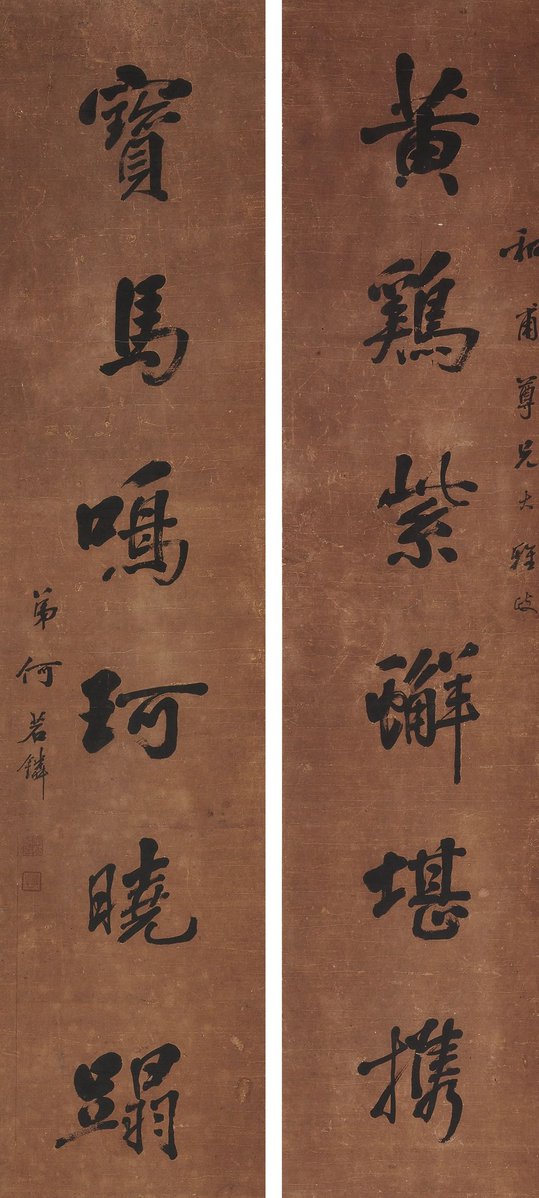

-
Details
- Place where the work was made
-
China
- Period
- Qing dynasty 1644 - 1911 → China
- Media categories
- Scroll , Calligraphy
- Materials used
- pair of hanging scrolls; ink on paper
- Dimensions
-
169.3 x 69.0 cm overall (variable)
:
a - right scroll, 138.7 x 27.9 cm, image
a - right scroll, 169.3 x 34.5 cm, scroll
b - left scroll, 138.7 x 27.9 cm, image
b - left scroll, 169.3 x 34.5 cm, scroll
- Signature & date
Signed c.l. part b, in Chinese, inscribed in black ink “…He Ruolin”
Signed l.l. part b, in Chinese, stamped in red ink “He Ruolin yin [artist's seal]".
Signed l.l. part b, in Chinese, stamped in red ink “Zhan sheng [artist's seal]".
Not dated.- Credit
- Gift of Dr. James Hayes 2003
- Location
- Not on display
- Accession number
- 309.2003.a-b
- Copyright
- Artist information
-
He Ruolin
Works in the collection
- Share
-
-
About
‘Yellow chicken and purple crab should be savoured along with wine-drinking;
The precious horse jingled, treading on dust in the morning.’
Inscription and signature: Written for the appraisal of respective Mr Hefu. He Ruolin.Although the first line of the couplet was directly taken from a poem by the Qing dynasty poet Wu Weiye (1609–71), the image of the yellow chicken, crab and wine is ubiquitous in Chinese literature and is closely associated with the Chongyang or Double Nine Festival, which took place on the ninth day of the ninth moon. Customarily, this is the day for outdoor activities: climbing mountains, enjoying autumn scenery and picnics (chicken, crab and wine being favourite items for consumption). The expression of ‘precious horse’ and ‘jingling patents’ are symbols of illustrious and noble status. So the couplet expresses the unfettered lofty mood of the scholar-official, in which one experiences a temporary transformation from the life of a bureaucrat, to one who has cast aside the pressures of materialism in everyday life to enjoy nature’s simplicity and purity.
‘The Poetic Mandarin: Chinese Calligraphy from the James Hayes Collection’. pg.136.
© 2005 Art Gallery of New South WalesThe couplet, written on two narrow pieces of paper or silk, and hung either side of a large painting or doorway, is one of the most common forms of calligraphic art and has a long standing history in China. They first appeared in the Five Dynasties period (907-979) as pairs of plaques, carved after written master copies, to decorate architectural columns, courtyards and garden doorways. Couplets for indoor display, written on paper or silk, came into existence in the 17th century and gained great popularity in the Qing dynasty. The couplets themselves are either taken from classical poetry or contemporary literary works composed by the calligraphers themselves and their friends. A couplet is made up of two parts called the head and the tail. The two lines of verse are antithetically parallel. Formerly it was a very common practice to send them to friends or relations on such occasions as marriages and birthdays, or as condolences to families of deceased persons.
Asian Art Department, AGNSW, August 2003.
-
Places
Where the work was made
China
-
Exhibition history
Shown in 1 exhibition
The poetic mandarin: Chinese calligraphy from the James Hayes collection, Art Gallery of New South Wales, Sydney, 23 Sep 2005–27 Nov 2005
-
Bibliography
Referenced in 1 publication
-
LIU Yang, The poetic mandarin: Chinese calligraphy from the James Hayes collection, Sydney, 2005, 136, 137 (illus.). cat.no. 45
-
